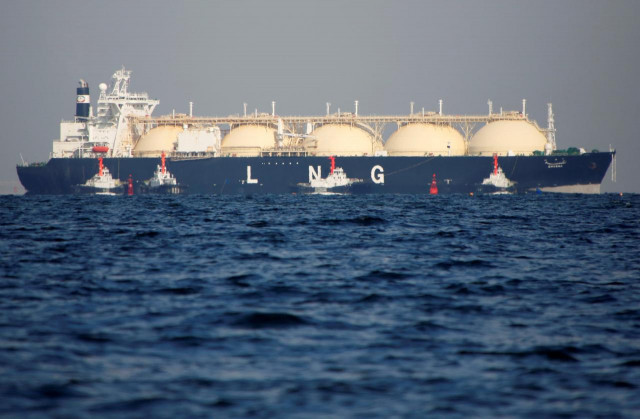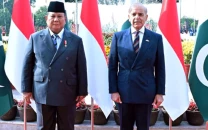Govt plans to increase LNG import from Qatar
Delegation leaves for Doha to talk additional supply of 200mmcfd

A liquefied natural gas (LNG) tanker is tugged towards a thermal power station. PHOTO: FILE
The decision came despite investigation by the anti-corruption watchdog into a previous long-term deal with Qatar for LNG supply to Pakistan for 15 years - an agreement signed during the tenure of previous Pakistan Muslim League-Nawaz (PML-N) government.
At present, Pakistan is importing 500 million cubic feet of LNG per day (mmcfd) from Qatar and has planned to step up imports to 700 mmcfd in order to run the second LNG terminal at Port Qasim at maximum capacity.
“A Pakistani delegation left for Qatar on Thursday to negotiate additional supply of 200 mmcfd of gas,” an official said, adding Petroleum Secretary and Task Force on Energy Chairman Nadeem Babar was part of the delegation.

However, the appointment of Babar as chairman of the energy task force has raised questions due to the conflict of interest.
The current Pakistan Tehreek-e-Insaf (PTI) government has been critical of the LNG import deal signed with Qatar by the PML-N government and the National Accountability Bureau (NAB) is investigating the matter.
The anti-corruption watchdog recently wrote a letter to Railways Minister Sheikh Rashid Ahmed, asking him to provide proof that the LNG deal with Qatar had been inked at a higher price of 13.37% of Brent crude. A special audit has pointed to a loss of billions of rupees due to the deal with Qatar.
Total capacity of the second LNG terminal is 750 mmcfd, but the government has allocated a capacity of 600 mmcfd. Pakistan LNG Limited (PLL) has secured dedicated supply of 200 mmcfd of LNG and the remaining 400 mmcfd is being imported through spot purchases.
“The government is of the view that spot purchase of LNG is not a solution and it needs long-term supplies to run the terminal at full capacity,” the official said, adding that the private sector had been seeking the allocation of idle capacity of 150 mmcfd at the second LNG terminal.
However, “now the government seems to be planning to utilise the entire terminal capacity as it is going to seek additional volume of 200 mmcfd of LNG from Qatar,” the official said.
PLL, Sui Northern Gas Pipelines and LNG consumers like independent power producers (IPPs) and compressed natural gas (CNG) filling stations were required to sign an agreement, but the private sector was reluctant to ink deal on a ‘take and pay’ basis.
Last year, the second LNG terminal was running at a low capacity in the wake of failure of state-run enterprises to import more LNG and refusal by power producers to place firm demand orders for LNG supply.
Consumers paid an additional cost of $45 million for the unutilised capacity of the second LNG terminal in 2018. “They are also likely to pay an extra $40 million in the ongoing calendar year if the tussle between the LNG supplier and consumers continues,” the official said.
Published in The Express Tribune, March 8th, 2019.
Like Business on Facebook, follow @TribuneBiz on Twitter to stay informed and join in the conversation.



















COMMENTS
Comments are moderated and generally will be posted if they are on-topic and not abusive.
For more information, please see our Comments FAQ